Layering Plants – Propagating by Rooting Layers.
‘Layering’ is a method of obtaining new plants by asexual or vegetative propagation.
Propagating plants by the ‘layering’ technique is one of these easiest ways to produce a few extra specimens from your choice shrub or houseplant. There are several methods of layering plants, but the one thing they all have in common, is that nothing is taken off the parent plant, until the layer has succeeded in producing additional roots.
Layering is particularly useful in producing extra plants from shrubs which are difficult to root from cuttings. As with taking cuttings, you are assured of reproducing an identical plant to the parent – a clone if you wish! With plants grown from seed, there can be wide variations in the vigor, general appearance and flower colour.
Types of layering include,
- simple layering; A stem is simply bent over to the ground and pinned down until a portion of it is rooted. It can then be detached from the 'parent' plant and grown on.
- serpentine layering; Normally the method used for fines or ivies. A long stem can be pinned down at various points until rooted. It can then be cut into rooted segments and grown as individual plants.
- Tip layering; A young tip is bent to the ground and pegged just below the soil surface and covered with soil or compost until rooted.
- Stool layering or Mound Layering: Suitable for shrubs that have strong basal growth - such as Cornus Dogwoods, Raspberries and Lavenders.
- Air layering. Involves leaving the stem growing naturally, making a cut near a leaf joint - holding it open with a matchstick - and wrapping the area in a plastic sleeve which is filled with sphagnum moss.
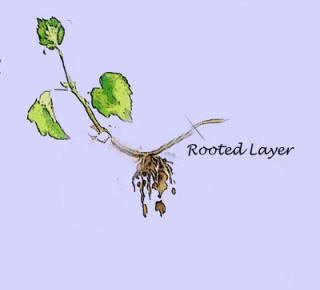 Stool layering is practiced at commercial
nurseries on a large scale – being the most efficient way of producing
extra stock of certain plants.
The other forms of layering are generally used when just an extra
plant or so is required; or with particularly difficult shrubs that do
not grow well from cuttings..
Stool layering is practiced at commercial
nurseries on a large scale – being the most efficient way of producing
extra stock of certain plants.
The other forms of layering are generally used when just an extra
plant or so is required; or with particularly difficult shrubs that do
not grow well from cuttings..
All methods of layering involve trying to get a stem to produce roots whilst still attached to the parent plant. The joints – or nodes as they are known – are important when taking ordinary cuttings, for most plants are ‘active’ at the nodal joint insofar as producing roots are concerned. That is why, when cuttings are taken, the cut is normally just below a leaf bud joint. Some – such as – clematis produce roots between the leaf joints rather than at the nodes.
Most active gardeners will have at sometime seen roots growing from a stem part that has either been damaged, or has been in contact with the ground. This is particularly the case where plants spread by stolons – stems which root individually as they creep away from the parent plant. Many perennial plants send out low growing shoots which invariably root into the ground.
Most layering techniques – other than air layering – involves bending a suitable stem down to the ground and then securing it either with a pin, peg, a mound of soil or even a brick!
The process can be started at any time of the year, but the spring is the best, with new, pliable shoots. Many shrubs have low growing or arching shoots or branches which can easily be pegged down to the ground.
Treating the Stem
Before pinning the stem to or into the ground, it is best to slightly
damage the underside of the stem – away from the bud – by scraping a
little bark off or making a shallow cut near the reverse of the dormant
bud. There is no
need for any other treatment, though rooting hormone can be used into
the damaged are if desired.
Where thick stems
are used for layering – such as older stems of Magnolias or
Rhododendrons – a cut near the leaf joint can be held open by simply
inserting a small piece of twig or even a small pebble.
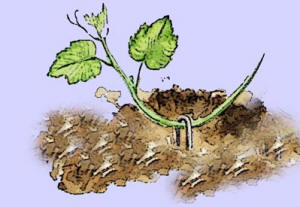
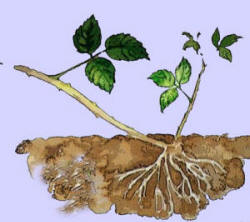
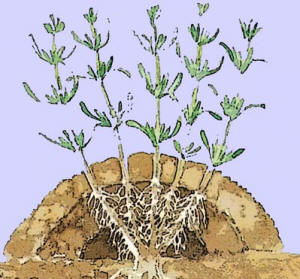
Basic Layering Technique; Tip Layer; Mound or Stool Layering:
Best Selling Gardening Products
Popular Gardening Sections

Problems
Identify Weeds in The Garden - How to deal with weeds. Diseases and Pest which harm your garden and plants, learn how to prevent, deter and erradicate your garden problems.
Garden Problems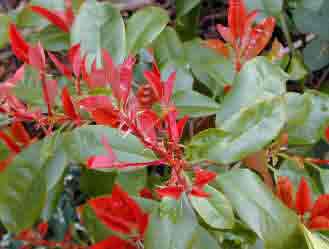
Pruning
Pruning Guide. Shrubs flower better with correct pruning. Many illustrations and examples of what to do - and when. Includes evergreens, roses, flowering shrubs, spring flowering shrubs and pruning for stem effect. This is our most viewed and comprehensive section,
Pruning
Gardening Businesses
Gardening Businesses listed in the UK counties and USA states. County and State Listings of businesses involved in Garden supplies and services. If you wish to be added to the Directory, please send us your information. Having problems, use the search box
Businesses
Gardening
In this section you will learn about Gardening Basics, Containers, Landscaping, Propagation and Soil.
Gardening
Gardening Gifts
Gardening Gifts and Reviews, Read Before you Buy
- Gardening Gifts Ideas
- Gifts For Her
- Gifts For Men
- Power Tool Gifts
- Cheap Gifts
- Personalised Gifts
- Wildlife Gifts
- Family Gifts



